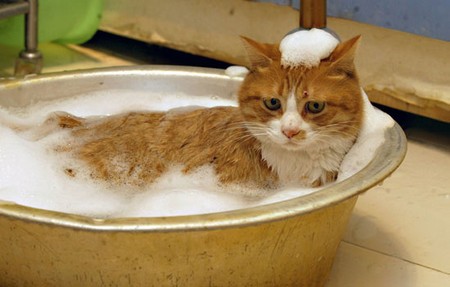Fortunately, cats do not need frequent bathing, although longhaired cats need more attention, particularly if you plan to show your cat. There is no doubt that adequate preparation beforehand can reduce the trauma a cat may feel. There is no ideal place in which to bath your cat, some owners use the hand-basin in the bathroom, others choose the kitchen sink, while some lucky cats actually have a baby bath bought for this purpose. If you choose the latter, make sure that it is placed on a firm base, otherwise any sudden movement from your cat can upset it.
Equipment: As well as a bath, you will need: a comb, a brush, blunt-ended scissors, towels, a bath mat. a flannel, a tumbler or jug, shampoo. Vaseline, cotton wool or cotton-wool balls, a hairdryer, claw-clippers, waterproof apparel and treats. Some of these items can be regarded as optional extras. After bathing your cat a few times, you will know what is required.
Training objective: To introduce your cat to the pleasures of having a bath.
Training steps
- Start to bath your cat at the earliest opportunity. If you are bathing your cat before his first cat show, bath him about 5-7 days beforehand to give his coat enough time to replenish its natural oils and regain its shine.
- Brush his coat a few hours before you intend bathing him to remove any excess loose hair and dead skin. If your cat has a longhaired coat, check to see there are no matted areas and if so, take appropriate action.
- Prepare the bathing area and gather the bathing equipment in one place.
- Clip your cat’s claws to reduce the chances of getting scratched.
- Provide yourself with waterproof apparel.
- Fill the bath to a depth of about 6 ins. Check the temperature of the water using your elbow.
- Tear off some cotton-wool, about the size of half a cotton-wool ball, use these as ear-plugs. Remember to talk reassuringly to your cat throughout the process.
- Wipe a minute amount of Vaseline on the lower lid of your cat’s eyes to protect them from water and shampoo.
- Lower your cat gently into the warm water. If this is his first contact with water, he will probably struggle. Keep calm and reassure him.
- Wet your cat with water from a tumbler or jug on his back. Let the water flow over his back gently rather than flooding him, which will only frighten him. Avoid his face unless it is very dirty. If you feel you must touch this area, use a clean flannel, wrung out with water to gently moisten his face. If his ears or around his eyes are dirty, these places can be attended to separately.
- When the coat is sufficiently wet, apply the cat shampoo and lather well. I give my cats two washes of shampoo and use less shampoo second time around, as this wash produces more lather.
- Rinse the coat, starting with the back first. Make sure that you remove all traces of shampoo, otherwise your cat’s hair will have a sticky, clumpy feel to it.
- Remove your cat from the bath and wrap him in a towel to soak up the excess water. Replace this with another dry towel and towel dry his coat. If you change rooms at this stage, make sure that the new room is adequately heated. If you use a hairdryer to dry the coat, keep it on low volume so as not to frighten him.
- Reward your cat with praise and his favourite dinner.
